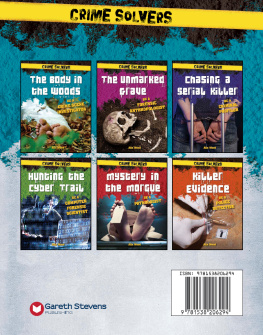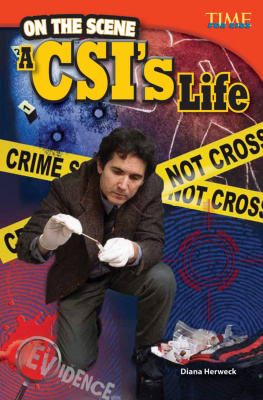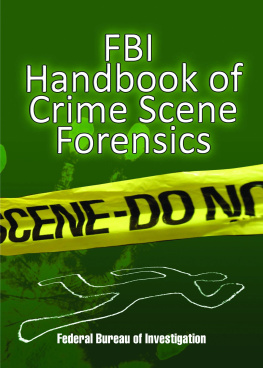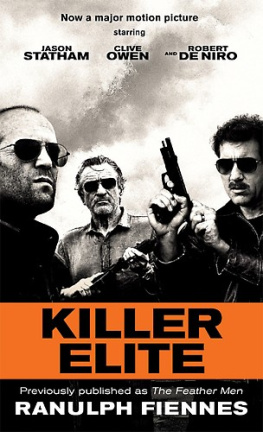Books in CSI: Crime Scene Investigation Series
CSI: Crime Scene Investigation
--09 In Extremis (10-2007)
Ken Goddard

A ruthless and expertly trained contract killer is on assignment in Nevada's remote DesertNationalWildlifeRange...and he deliberately sets in motion a series of seemingly unconnected events that will soon test the skills of Gil Grissom and his team of CSIs -- Catherine Willows, Nick Stokes, Warrick Brown, Sara Sidle, and Greg Sanders -- to their limit. For all is not as it appears in this federal refuge, as law enforcement and lawbreakers alike are quickly caught up in a growing crime scene that leads to a deadly game of one-upmanship...
Copyright 2007 by CBS Broadcasting Inc. and Alliance Atlantis Productions, Inc. All Rights Reserved.
ISBN-10: 1-4165-7199-X
ISBN-13: 978-1-4165-7199-5
In memory of San Bernardino Sheriffs criminalist John Davidson, an amazing fellow who taught me long ago to reconstruct shooting scenes with a slide rule and a set of trig tablesand of Whittier (CA) PD Sergeant Tom Lamping, a recently lost buddy who faced life and adversity with the heart of a devoted husband, loving father, skilled craftsman, and tough cop.
Acknowledgments
My sincere thanks to my editor, Ed Schlesinger, who has a very keen sense of suspense and mystery, not to mention a questionably evil gift for keeping readers guessing; and to my literary agent, Eleanor Wood, who has remained amazingly supportive and encouraging all these years.
And a special thanks to my longtime criminalist buddy, Luke Haag, who brought the entire science of shooting scene reconstruction forward in his wonderfuland aptly namednew reference book that, in my certainly biased view, ought to be required reading for all CSIstrainees, practitioners, and dinosaurs alike.
Luke, like many other old-timers in the field (myself included), is an advocate of the idea that while performing their work in a carefully methodical, analytical, and ethical manner, forensic scientists should never forget that their proper role in the lab or at a crime scene is to think about the significance of the evidence that lies before their eyes. The following comment regarding the accreditation-driven trend of crime labs in the U.S. (and throughout the world) to establish rigorous protocols for each and every examination their scientists perform; thusintentionally or otherwiseestablishing menus of tests for the investigators to select from when they submit their evidence is apt and timely:
In this strictly reactive role the forensic scientist is no longer functioning as a scientist at all. Rather he or she has been reduced to the role of a technician.
He or she may be doing the requested tests correctly and in accordance with some approved, standardized, certified, or accredited methodology but they are not fulfilling the true role of a forensic scientist.
Lucien C. Haag, 2006,
SHOOTING INCIDENT RECONSTRUCTION
LIKE THE YOUNG MULE DEER in his rifle scope, Viktor Mialkovsky was a patient creature who preferred to spend a great deal of time monitoring his surroundings before making a decisive move.
But unlike that timid mammalwho now sat trembling in fear approximately two hundred yards from his high-point position overlooking the rocky clearing belowMialkovsky was the furthest thing imaginable from harmless.
Thanks to a considerable amount of progressively intense training and experience, all paid for by the United States government, Viktor Mialkovsky was perfectly capable of killing human and wildlife alike with a wide range of lethal weapons that specifically included his bare hands. As a result of that same training and experience, he was also considered an expert hunter, tracker, and survivalist by the small number of peers and supervisors who were personally aware of his skills. On the summary sheet in his personnel jacket, the words mission-oriented and emotionally detached had been highlighted and underlined for emphasis.
Had Mialkovsky possessed a similar degree of camaraderie, and respect for teamwork and authority, he would have been the ideal government hunter-killer: an infinitely adaptable human weapon to be judiciously applied to the most difficult tactical problems. That was certainly the plan, as far as the succession of people responsible for his training and duty assignments had been concerned.
But it hadnt taken each of these veteran supervisors long to conclude that their supposedly ideal hunter-killer was indifferent to authority and regulations in general, to the rules of engagement in particular, and to the other men and women attached to his missions without exception. Most of them were convinced that Mialkovskys heralded emotional detachment had far less to do with his ability to control his emotions than with a general lack thereof.
These were serious flaws that should have terminated Viktor Mialkovskys government career long before his skill set became unmanageable; and certainly would have, had he not also possessed from early childhood an almost feral ability to conceal himselfboth his mind and his bodywithin the organizational structure of his environment.
No aptitude or personality test ever confirmed the suspicions of his supervisors, none of his questionable actions had ever been documented, and no eyewitnesses had ever stepped forward to report what they had heard or seen.
In effect, to his supervisors and to his external world at large, Mialkovsky remained irrefutably who and what he chose to be at any particular moment.
And that, in addition to his formidable skill set, made him extremely dangerous to anyone or anything that happened to cross his path.
Thus the fact that Mialkovsky and the young mule deer had chosen to conceal themselves on adjacent sets of narrow rocky mesas overlooking this particular high-mountain clearing on this particular night certainly bode nothing good for the animal. But the presence of the terrified deer seemed only to amuse the supposedly emotionless hunter-killer, who had briefly held the deers head in his crosshairs before methodically shifting his view to the next sector.
It was a casual decision that would have undoubtedly intrigued the legion of government psychiatrists who had diligently probed Viktor Mialkovskys psyche over the years with their batteries of standardized but ultimately unrevealing tests.
This particular decision by Mialkovsky was revealing, because it would have taken the hunter-killer only a fraction of a second to send one of his modified 7.62x51 NATO hollow-pointed bullets through the deers exposed head. In doing so, he would have confirmed the functionality of his primary weapon, acquired some extra meat for his freezer, and reduced the number of unpredictable factors at the scene by one; all positive results achieved at minimal risk to his intended task.
Very mission-oriented, indeed.
And, in fact, during that brief and thoughtful moment, he had considered squeezing the trigger of his silenced bolt-action rifle, for the simple purpose of double-checking the accuracy of the 80mm-wide-aperture ATN 4-12X80 day-night telescopic sightand to make the next few hours a bit more interesting.
But, ultimately, he chose not to do so, for five very specific reasons.
First of all, hed come here to hunt a different species.
And hed already sighted in the scope after hed parked and concealed the dune buggy back down the trail.
And he really didnt need another deer for his freezer, because he didnt have a freezer; at least not in this state.
And he didnt consider the animal a significant issue in terms of the overall scene.
Next page







